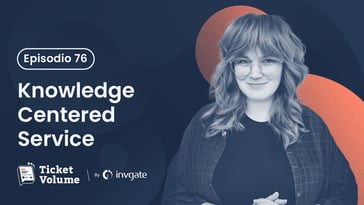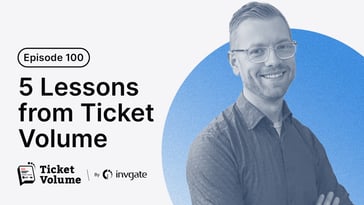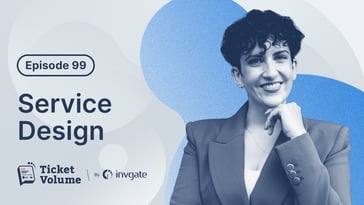Many organizations claim to offer personalization but need to improve in practice. Examples include irrelevant recommendations based on user preferences or past behavior. It all feels fake.
Roy Atkinson had a lot to say about that on the 26th Episode of Ticket Volume, our IT podcast, where he expressed a desire for more organizations to truly personalize their interactions with customers while explaining the intersection between customer experience (CX) and IT since that is where personalization should occur.
Atkinson is a top influencer in the Service Desk and Support industry, named one of the Top 50 Customer Service Experts of the Decade by Nextiva. His expertise has been featured in The Economist, Social Media Today, Computer World, BizTech Magazine, and more.
We strongly encourage you to listen to the entire episode for a more immersive experience. Don't forget that you have the option to register for our monthly live recordings, where you can actively participate and have your questions answered in real-time.

How IT businesses create a personalized customer experience
The intersection between CX and IT is crucial for effective personalization. Personalization in CX involves tailoring products, services, and interactions to meet individual customer preferences and needs. IT plays a significant role in enabling and enhancing personalization by collecting and analyzing customer data, segmenting customers based on characteristics and preferences, and utilizing Customer Relationship Management (CRM) systems.
|
|
"In one way or another, whether it's in-house or outsourced, or embedded in the business or a department of the business, it's I.T. (...) Information Technology drives so much now: It drives all the media contacts, it drives customer experience, it drives everything." Roy Atkinson |
Through these means, IT empowers organizations to create personalized experiences, track customer interactions, and improve overall customer satisfaction. But, for Atkinson, organizations that claim to be data-driven often fail to deliver true personalization.
It’s necessary to remark that CX and employee experience (EX) have many overlaps and interconnections. So much so, that digital customer experience is becoming more prevalent due to changes in communication channels.
Atkinson claimed IT plays a crucial role in enabling digital customer experiences. That is because traditional phone conversations are being replaced by social media, messaging apps, and mobile websites.
He believes CX should be seen as personal and unique to each individual, hence organizations need to understand and respect individual experiences by focusing on one person at a time rather than groups or cohorts.
The speaker has a unique perspective and organizations need to hear different viewpoints. Don't lose sight of the customer in CX. Customer experience should be personalized and not treated as a group experience.
AI is changing things in the personalization of CX
Atkinson mentioned the potential of Artificial Intelligence (AI) in analyzing recorded calls in contact centers. Thousands of hours of calls are recorded, which would be impossible for humans to analyze effectively. Machine learning and AI can help extract information from these calls, such as mentions of competitors and customer sentiment. Now, his points about how to approach these changes are key:
- Contact centers are becoming more central to organizations due to the valuable data they possess. They have access to customer feedback and comments, often considered dark data. Technology can now analyze this data at scale, providing previously inaccessible insights.
- Traditional chatbots that rely on keywords are becoming outdated. AI-powered chatbots, known as interactive virtual assistants (iBAs), offer a more engaging and human-like interaction. Customers dislike the wasted time and expect efficient support, making advanced chatbots essential.
- Imitating humans entirely with chatbots is not the right approach. Blended intelligence is more effective, meaning combining the skills of machines and humans leads to better results. Augmented intelligence refers to the powerful combination of human and machine capabilities.
- Pairing human elements with AI can provide personalized support. The example of Amazon having someone review suggestions for a specific user demonstrates the potential of blending human and machine intelligence.
Here is where we are missing the mark
Atkinson is surprised that people approach him without doing basic research on their company. They emphasized the importance of doing homework before contacting someone and advised the podcast listeners to be prepared when reaching out to interested parties.
Also, some may violate business ethics or might be big red flags. Atkinson shared an incident where someone contacted the speaker after buying a list, assuming they met at a conference. That is why he highlighted the significance of making ethical choices in business and mentioned that such actions can create a poor experience for others.
Basically, small choices, like sending emails or purchasing lists, accumulate and impact overall business ethics. In these cases, dishonesty will eventually be exposed. So be authentic!
For that, analysts need to listen attentively to what companies share while maintaining skepticism about their claims. These are the two types of analysts Atkinson described:
- Those who focus on technology and people aspects within industries (e.g., customer experience).
- Financial analysts who assess stock performance, financial health, and investor relations.
Internal perspectives often focus on business goals, while external perspectives consider the lived experiences of customers. Customer journeys capture the true experiences of customers, not just business processes or value streams. Becoming a fan of a brand involves going through multiple stages and interactions.
Bottom line
This is just a short recap of Ticket Volume's episode with Roy Atkinson, but there's much more on the recording. So, make sure to catch up on the full chat with Matt Beran to learn more about personalized customer experience and how he broke down the customer journey into eight stages. Each stage is part of a cycle, where customers become advocates and influence others' discovery process. You would love to listen and take some notes.
You can find the full episode on Apple Podcasts, Spotify, YouTube, or your favorite podcast platform. And remember to subscribe if you want to be a part of the monthly live recordings!















